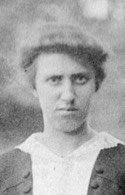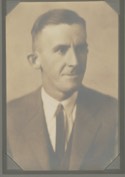Farabaugh Family History - Person Sheet
BirthJun 16, 1891, St. Boniface, Pa.
DeathJan 27, 1974
BurialHoly Hope Cemetery, Tucson, Az.
FatherFrancis Englebert Farabaugh (1862-1930)
MotherTheresa Anna Anna (1865-1941)
Spouses
BirthMay 29, 1894, Vicksburg, Miss.
DeathMar 5, 1936, Tucson, Ariz.
BurialCedar Hill Cemetery, Vicksburg, Miss.
FatherJames J. Phelan (1847-1906)
MotherElizabeth F. O'Donald (1853-1936)
MarriageOct 3, 1927, Tucson, Arizona
Notes for Bertha Clotilda Farabaugh
“Bert” was raised in Carroll Township, Cambria County, Pa. She was a laborer in the family feed mill, but according to family lore her father Frank sent her to Arizona to look after her younger sisters Agnes and Mary, the latter of whom suffered from tuberculosis. Bert met, and stayed to marry, Bernard Phelan there. Bertha belonged to the Adoration Society for the Benedictine Convent in Tucson, Az., for over 25 years. She taught in the Tucson public school system and is remembered for having an extensive salt and pepper shaker collection.
Notes for Bernard Joseph (Spouse 1)
Barney was raised in Vicksburg, Miss. After graduating from St. Aloysius High School in 1912, he went to work as a railway clerk for the Illinois Central Railroad in Memphis, Tenn. He was drafted into WWI and was assigned to the 140th Field Artillery unit at Fort Sill, Okla. He was discharged as a sargeant in the Fall of 1919. He then returned to his former job as a clerk in Memphis. In about 1924, he relocated to Tucson, Az., to work for the Southern Pacific Railroad. It was there that Barney met and married Bert Farabaugh. The 1930 Census, however, indicates he was single, working as a railroad machinist and living with his widowed mother in Vicksburg. He liked to smoke black Mexican cigarillos. he died of tuberculosis, and was working as a railroad clerk at the time of his demise.
Barney and Bert’s life was recounted in more detail by their son Bernard Jr. “Barney and Bert lived in a series of cramped rentals in the less fashionable south part of [Tucson]. This must have been a downgrade as Bert had lived in the spacious two story house built by her prosperous father. They had a car, a Whippet, but no radio. Their last move was to a former Ranch/Farm house on the outskirts of south Tucson. They occupied the front half of a divided brick house with a large front porch where we slept on hot summer nights. There was only one bedroom, but it was supplemented by a curtained off hallway as a second option. At one point, Bert rented out the front living room. There was a cast iron stove in the living room. I remember getting kindling from grocery store boxes to feed it. We used a portable kerosene space heater in the other rooms. Interestingly enough, it had a solar heated hot water tank on the roof. The lot was planted with three kinds of grapes, fig trees, a plum tree, an olive tree and pomegranate. They kept chickens to supplement the menu. Next door was a junk yard, just made for after hour play. There was a bar on both corners.
There was certainly an emphasis on education in the family. I remember alphabet drills as a four or five year old. Although Barney was out of work, they sent me to kindergarten. In 1934 they sent me and later my sisters to SS Peter and Paul parocial school on the affluent north side of town. Students were drawn from the well off, merchants, professors, doctors. It was an unusually progressive school, with class plays every year. It cannot have been cheap.
It is remarkable to me that after Barney’s death in 1936 that Bert was able to keep us at SSPP. After all, she had no education and had to make her living as a housemaid, baby sitter, washer woman, competing with Indian and Mexican labor in the middle of the Depression. Even more remarkable is she found a way to put me through the Unitversity of Arizona and my sisters through the expensive St. Joseph’s Academy (Villa Corondelet) and later St. Mary’s Nursing School. She had been invited by her mother to return and live in Patton. She turned her down, saying she thought the opportunities for children were greater in Tucson. History proved her right. Patton withered and education was readily available in Tucson. . .
. . . It is strange to think back and not realize that we were obviously poor. I remember cardboard in my sneakers and glued on soles to my dress shoes, but i never felt disadvantaged or hungry. Bert was a poor cook, our mainstay was potatoes and hamburgers. There was a daily trip to the outlet bakery for day old bread. We never noticed.
In 1940, using a small bequest from Barney’s mother, she bought a 800 square foot home. She added a wooden screened addition to make a third bedroom for herself. No heat, no air conditioning, just a small gas stove in the living room. But it was hers. She lived there the rest of her life and walked every day to church, a half mile away. She stopped only after being injured in a mugging. The last years of her life were spent with her daughter Elizabeth.
Her real recreation was cards, and she was a whiz at it. In the 1960s she was recognized on a current national radio show as “Queen for a Day,” on the recommendation of her friends for her activities. . .”.
Barney and Bert’s life was recounted in more detail by their son Bernard Jr. “Barney and Bert lived in a series of cramped rentals in the less fashionable south part of [Tucson]. This must have been a downgrade as Bert had lived in the spacious two story house built by her prosperous father. They had a car, a Whippet, but no radio. Their last move was to a former Ranch/Farm house on the outskirts of south Tucson. They occupied the front half of a divided brick house with a large front porch where we slept on hot summer nights. There was only one bedroom, but it was supplemented by a curtained off hallway as a second option. At one point, Bert rented out the front living room. There was a cast iron stove in the living room. I remember getting kindling from grocery store boxes to feed it. We used a portable kerosene space heater in the other rooms. Interestingly enough, it had a solar heated hot water tank on the roof. The lot was planted with three kinds of grapes, fig trees, a plum tree, an olive tree and pomegranate. They kept chickens to supplement the menu. Next door was a junk yard, just made for after hour play. There was a bar on both corners.
There was certainly an emphasis on education in the family. I remember alphabet drills as a four or five year old. Although Barney was out of work, they sent me to kindergarten. In 1934 they sent me and later my sisters to SS Peter and Paul parocial school on the affluent north side of town. Students were drawn from the well off, merchants, professors, doctors. It was an unusually progressive school, with class plays every year. It cannot have been cheap.
It is remarkable to me that after Barney’s death in 1936 that Bert was able to keep us at SSPP. After all, she had no education and had to make her living as a housemaid, baby sitter, washer woman, competing with Indian and Mexican labor in the middle of the Depression. Even more remarkable is she found a way to put me through the Unitversity of Arizona and my sisters through the expensive St. Joseph’s Academy (Villa Corondelet) and later St. Mary’s Nursing School. She had been invited by her mother to return and live in Patton. She turned her down, saying she thought the opportunities for children were greater in Tucson. History proved her right. Patton withered and education was readily available in Tucson. . .
. . . It is strange to think back and not realize that we were obviously poor. I remember cardboard in my sneakers and glued on soles to my dress shoes, but i never felt disadvantaged or hungry. Bert was a poor cook, our mainstay was potatoes and hamburgers. There was a daily trip to the outlet bakery for day old bread. We never noticed.
In 1940, using a small bequest from Barney’s mother, she bought a 800 square foot home. She added a wooden screened addition to make a third bedroom for herself. No heat, no air conditioning, just a small gas stove in the living room. But it was hers. She lived there the rest of her life and walked every day to church, a half mile away. She stopped only after being injured in a mugging. The last years of her life were spent with her daughter Elizabeth.
Her real recreation was cards, and she was a whiz at it. In the 1960s she was recognized on a current national radio show as “Queen for a Day,” on the recommendation of her friends for her activities. . .”.


